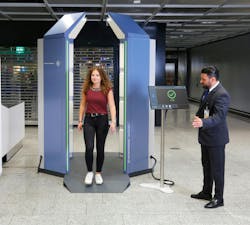Millimeter Wave Scanners: Loss Prevention for Logistics Centers
This article originally appeared in the August 2024 issue of Security Business magazine. Don’t forget to mention Security Business magazine on LinkedIn and @SecBusinessMag on Twitter if you share it.
In an age of online buying that exploded in the COVID years and has continued to this day, logistics warehouses and distribution centers have been a central aspect of consumerism in America and beyond. Amazon alone has more than 800 warehouse facilities in North America, each employing roughly 1,000 to 1,500 workers sorting through myriad products and preparing them to ship.
With so many people and tens to hundreds of times as many assets to protect, loss prevention teams overseeing these facilities are faced with a monumental task. How can integrators help? As is often the case, technology is the first answer.
"If you talk about assets in logistics, it is not only the products themselves or the items produced, but it includes a number of other assets, both material and immaterial," Peter Walhöfer, Director of security scanner sales for Rohde & Schwarz, explained during a recent webinar. "It could be money, IP (Intellectual Property), company secrets, raw materials, tools, and more."
Whether it is a meat packing plant or an Amazon fulfillment warehouse, a primary concern is employees leaving with merchandise; thus, the natural solution is extensive staff screening upon exit. For data centers and other warehousers of data, entrance screening is also a prime concern, looking for employees with data collection devices such as SD cards or flash drives.
Traditional entrance/exit screening methods typical to facilities like airports and government facilities may not be the answer, as they are not efficient enough to enable the smooth throughput of hundreds of employees at a time without the use of hundreds of security staff and the increased costs that come with it.
For Munich, Germany-based Rohde & Schwarz, the solution is millimeter wave technology, in the form of walk-through security screening technology focused on extremely high throughput and minimal disruption. “People can walk through the scanner at their normal pace, just like walking through a doorway,” the company explains in its QPS Walk2000 product documentation. “There is no need to pause and pose, and no need to remove shoes or outerwear. The unit can scan up to 750 persons per hour, minimizing queuing to help businesses manage peak time shift changes.”
What makes the millimeter wave technology so advantageous to this application is the fact that it can detect so many different items, no matter the composition. It can detect non-metallic items such as plastics, ceramics, liquids, and precious metals. The scanners also incorporate machine learning algorithms to train them to focus on specific objects or object classes, which can be continuously updated.
“We are using artificial intelligence-based detection algorithms, which are specifically trained to the aspects and challenges of loss prevention,” Walhöfer explained. “AI-based automatic target detection helps to speed up the process. It requires fewer operator personnel, and there's no specific training and qualification needed. On top of this, we are developing and implementing automatic and remote [unmanned] screening solutions, which again helps to reduce operations staff needed.”
Another key aspect of such a solution is user acceptance. Walhöfer explained that the safety of millimeter wave technology and the privacy settings it enables are keys to user acceptance.
“Acceptance of any people screening measure is highly dependent on the feeling of the people who are being screened. Privacy protection and consideration of health and safety aspects are the reasons why millimeter wave is the gold standard in aviation security because it uses non-ionizing, low-power radio waves that are fully reflected on the surface of the skin. They are non-problematic even for people wearing medical devices, medical implants, or for pregnant women.”
In the webinar, Walhöfer goes on to cite application examples, ranging from the cosmetics industry to consumer electronics, fulfillment centers and warehouses, data centers, pharmaceutical production, chip makers, money handlers and banks, military applications, and more.
“A nice example is meat production,” he said. “We have a client who told us that workers were carrying out meat wrapped around the body in high quantities. Yes, the millimeter wave scanners can detect meat on meat – meat on your body.”
For integrators, selling a customer on making such a high-tech investment may be a challenge; however, Walhöfer said the overall ROI makes easy sense in this application. “Deterrence measures are an investment rather than a financial burden,” he said. “It helps reduce financial losses, maintain business continuity, protect image and reputation, and improve employee morale.”
Watch the full 15-minute webinar here (registration required).

